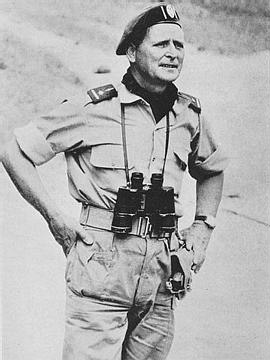Congo 1964-65

“Mad Mike” Hoare, mercenary leader, in 1964
Chapter five of the book describes how in the 1970s at least one, and possibly two, easy win interventions were mounted by the United States in what was then called Zaire. These, however, paled by comparison with the covert war run by the CIA during the preceding decade. In late June 1964, rebels led by followers of Washington 's former nemesis, Patrice Lumumba, launched attacks in Kivu province. The Congolese army immediately collapsed, its soldiers fleeing the invaders, while raping and pillaging along the way. By late July, the U.S. embassy was frantic, and this was before the country's third largest city was captured by the rebels. As we saw in chapter four and as might have been expected, the U.S. tried to get the former colonial power, Belgium to intervene, but it refused, along with other of Washington 's European allies. African countries also said no and so U.S. officials, worried that time was “running out” for the Congo to “be saved,” turned to white mercenaries from South Africa and Rhodesia, with a smattering from Europe. By October, there were over a thousand of them. Although technically the mercenaries were hired by the Congolese government, in fact they were shipped in, paid, equipped, and overseen by the U.S. (both the CIA and the military), albeit with some Belgian participation.
Unlike their successors in 1977 and 1978, the rebels were tenacious, and thus in order to advance, the mercenaries received extensive air support from a CIA force. Already in early 1964, a rebellion at the other end of the country had been put down by a small squadron of Italian-made aircraft flown by Cuban veterans of the Agency's abortive Bay of Pigs invasion. This unit served as the nucleus for the Congolese air force (in which there was not a single Congolese) and its operations on behalf of the mercenaries. The Cubans, aided by other pilots recruited from the mercenaries, carried out bombing and strafing runs in B-26s and T-28s supplied by the Defense Department and a CIA proprietary; these had a devastating effect on the rebels and contributed significantly to the mercenaries' eventual victory. Another CIA proprietary, this one chartered in Liechtenstein , helped to maintain the aircraft and also patrol boats used against rebels on the shores of Lake Tanganyika (the crews of those boats were South African, also hired by the CIA). For various reasons, ranging from a concern over “another Vietnam ” to the obvious political embarrassment of backing white mercenaries from racist regimes, almost none of the U.S. actions (overt aid to the Congolese regime was the exception) could be acknowledged. 1
1) “Another Vietnam Feared in Congo”; “How C.I.A. Put ‘Instant Air Force' Into Congo”; both New York Times , 13 December 1964, 26 April 1966; Lemarchand (1976: 407-8, 413); Weissman (1979: 271-3); Hagendorn and Hellstrom (1994); Holm (1999); Gleijeses (2002: chs. 3, 6-7). The U.S. also induced the Belgians to carry out a paratroop landing (from U.S. planes) in Stanleyville, the major city earlier captured by the rebels, in order to rescue European hostages; but this operation, similar to the standard evacuation efforts undertaken by various imperial powers on behalf of their citizens, was only a minor part of the U.S. intervention.
